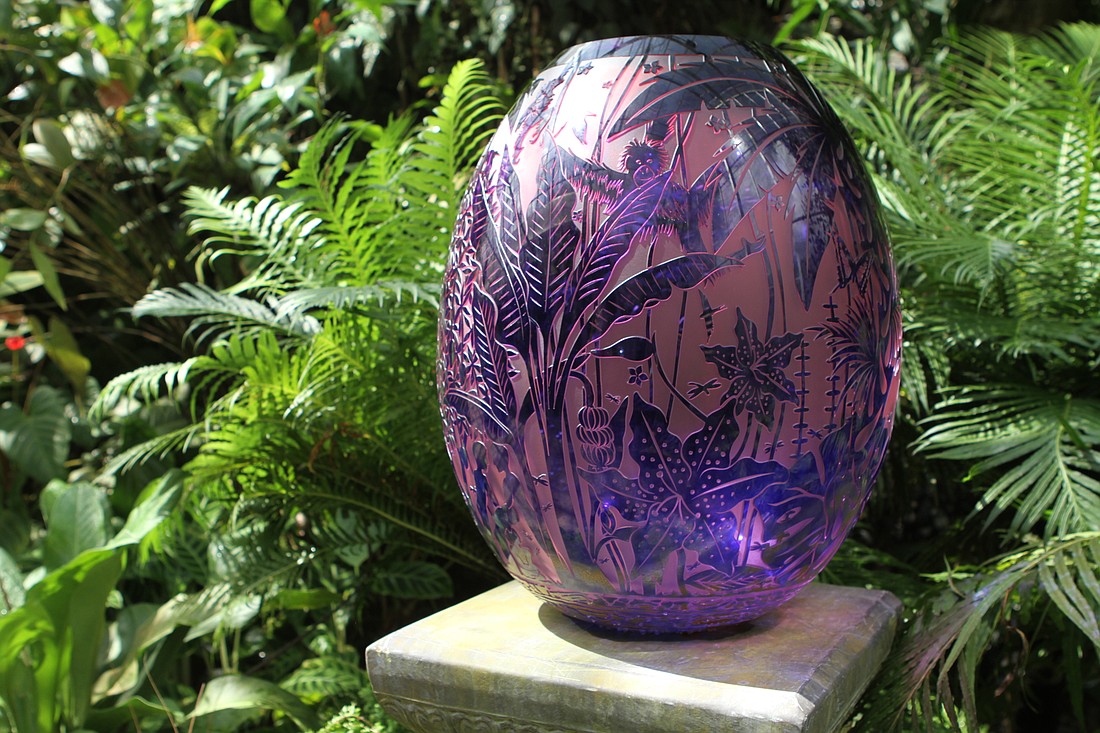- April 11, 2025
-
-
Loading

Loading

Glass art is, if nothing else, an involved medium.
It requires an artist with a specific vision, people to help them manage the process and plenty focus.
Flames close to 2,000 degrees melt the glass so the artist can spin and shape it into something new. After hours of work and care, the glass takes its final shape — the idea made real.
It requires patience, focus, and teamwork. But every artist can tell you when the glass is cooled and clear, and the light strikes it at just the right place, their work shines.
Glass artist Duncan McClellan took to that shine as a child visiting a glass factory in West Virginia. His fascination with the colors and craft he saw has endured all his life — he now has a renowned glass art gallery in St. Petersburg with a workshop that teaches dozens of artists how to make their own creations.
Sarasota residents can see those works for themselves at Marie Selby Botanical Gardens with "In Dialogue with Nature: Glass in the Gardens,” a glass show highlighting more than 40 glass works from McClellan and his studio artists. The third annual exhibition opened Aug. 8 and finishes in September.
This year’s show has a botanical nature focus, with the glass pieces supporting that theme. The art is spread across several areas in the gardens, including its greenhouse-esque tropical conservatory. That organic, natural environment brings out the color and light in the glass that McClellan treasures.
“What other medium is both transparent, translucent, and opaque?” McClellan says. “Glass is made for light.”
Lauren Hill, Glass Artist
Lauren Hill has been an integral part of McClellan’s glass operation for some time. She is director of the nonprofit DMG School Project and heads the hot glass studio where studio artists create their works. Hill worked with Selby staff on the placement of the many glass pieces in the gardens.
Her contribution to the glass show is an old joke-turned-signature creation, a collection of bright and vibrant glass peaches. Someone gave her the nickname “Peaches” when she was just starting at the studio, so she decided to make her name into something real.
“They make me happy and seem to make everyone else happy,” Hill said. “They’re just really fun to make.”
Hill and assistants start with a color overlay that adds shades of yellow to a clear bubble. She then adds sprinkles of powder after the first layer that gives the glass speckles of color. What follows is “hot sculpting” where she creates a frog figure out of glass bits that’s added to the peach glass. One person has to keep the peach at 1,000 degrees, or the glass will crack.
It’s a team effort that takes around three hours to finish, but Hill emphasizes it’s taken her 14 years to bring it down to that time.
She’s made countless peaches but still hasn’t found one she’s fully proud of. That’s why she keeps trying.
“None of them turn out perfectly, which keeps me going back to glass,” Hill said. “It’s so challenging.”
Richard Logan, Glass Artist
Richard Logan has three pieces hung over the fireplace in the Selby museum, each overlaid with an etching of a different animal. The Bird, Gecko and Turtle etchings are placed over colorful images of verdant nature — it’s a mix of photography, metal and glass work that he considers his version of Pre-Columbian art.
The artist takes photos of nature, and puts a digital print on film, which he then transposes to metal which he then mixes with chemicals. All in all, the process can take more than 30 hours.
Logan started as a painter, which led to photography, which led to McClellan offering him one of the first residencies at his workshop.
The mixture of metal work with glass and color is what interests Logan. When you walk around the exhibit, the etchings can seem 3-D. He sees things he could have done differently, too much metal showing or not quite enough, but there isn’t much to do at that point.
“I realized a long time ago that you've got to stop at some point,” Logan said. “I feel it's OK to show and I move on.”
Dan Alexander, Glass Artist
Dan Alexander likes to create flowers out of glass — his sketches are full of lotus flowers.
His work of late has been multi-colored, full constructs with layers of petals that build on top of each other and reach upwards. Several of his glass sculpture flowers are now on display in the garden’s museum.
With the help of two other people, Alexander creates a petal at a time — as many as Alexander feels is right — and slowly adds them together. The process takes hours but eventually, the greater design takes shape. Alexander then breaks the flower off the metal rods it’s rested on and grounds the bottom to lay flat in Selby’s glass case. The finished creation is something intricate and, Alexander hopes, calming.
“(The lotus flower) is a very beautiful flower, even though it can be grown in kind of mucky dirty waters,” Alexander said. “Even though there's a lot of rough things going on in the water, or in the world for this matter, a lot of good things could still come out of it.”
Alexander says he’s fascinated by making glass, the way it shifts and reforms throughout the process. It’s not easy, one wrong change in temperature can leave his flowers cracked.
There’s pride when he’s finished with a new flower, but he always notices something that could be better. The work continues.
“Every piece that I make, I always look at something that I could do differently or improve upon,” Alexander said.